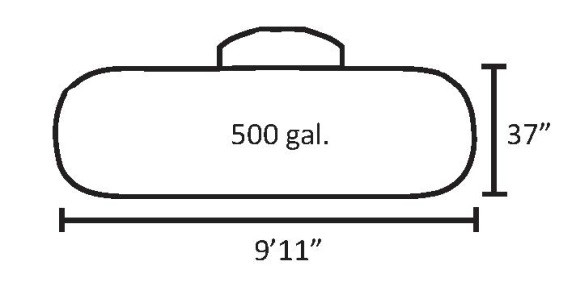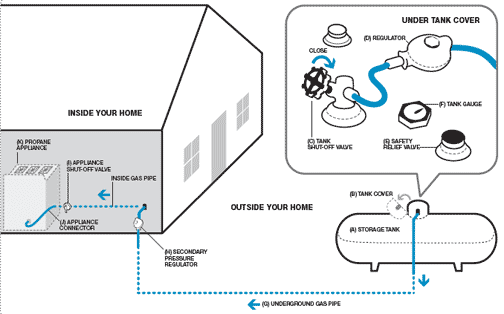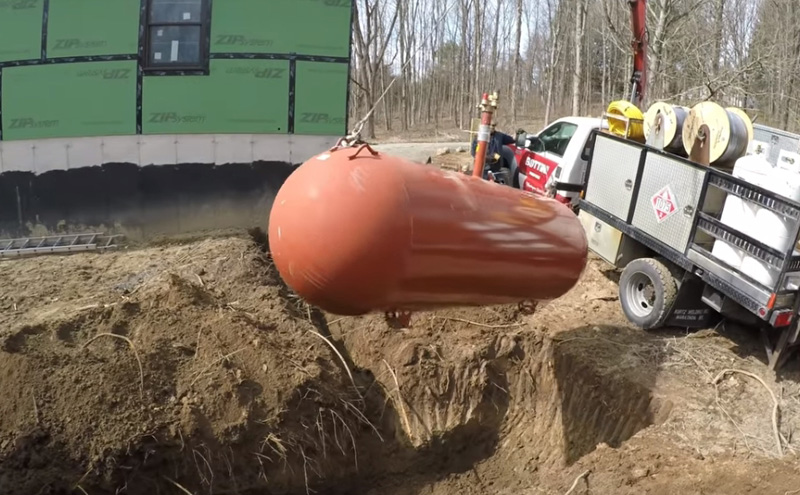You can expect an average 500 gallon propane tank weight to be about 2,876 pounds (1,305 kg) when full. This includes both the weight of the tank and the propane inside.
An empty 500 gallon propane tank weighs about 1,180 pounds (535 kg).
Liquid propane weighs 4.24 lbs/gallon (1.92 kg/gallon).
Your 500 gallon propane tank can hold 400 gallons of propane inside, which weighs 1,696 pounds (769 kg).
This tank's holding limit of 400 gallons is due to the 80% full rule for propane tanks.
500 gallon propane tank BTU = 36,600,000 when full (80%).
These large tanks have been built to work both above or below ground. The propane tanks feature treated steel to reduce the potential for corrosion over time.
Propane tank 80% fill limit
The reason you can only fill your 500 gallon propane tank to 400 gallon of propane is to leave room for temperature fluctuations. Propane, like water, expands when heat is added to it. However, propane will increase in volume over 17 times the amount that water does. To give room for this expansion, propane tanks are only filled to 80% of their total container capacity.
This means that a tank in the summer months could read 80% full on a regular day, and read over 85% full on a very hot day. For this range of temperatures based on weather, there is extra room left in the tank. This allows additional space and cushion in the tank for the pressure build up on warmer days.
500 gallon propane tank transport and installation
The best way to transport a 500 gallon propane tank comes down to two options. You can either move it yourself DIY style, or hire a company to do the installation.
Option #1 - DIY installation
For those picking up a used tank from Craigslist or Facebook marketplace for example, you'll want to move it yourself. To do this I'd recommend you first have access to a vehicle that can tow at least 3,000 pounds (1,361 kg). Be sure to check your vehicle's towing capacity, and gross vehicle weight rating (GVWR) before moving the tank.
You'll also want to check that the tank is empty (or close to it). This will make towing it much easier and lighter.
The following YouTube video shows how to transport a 500 gallon tank by yourself:
Option #2 - Hire a company
If you lack the proper equipment or would rather have a professional handle the job for you, you can choose to hire a company for the installation. This will cost more, yet you can rest assured that it's been done the right way. If you have acquired a used tank yourself, companies also offer their services to connect it to your property.
The installation process with a company usually takes around 3 to 4 hours depending on the terrain, and whether it's placed above or below ground.
The following YouTube video shows installing a 500 gallon tank underground:
In either case it's also important to place your propane tank at least 10 feet away from any buildings or property lines. This is a safety precaution in case the tank malfunctions or has a leak.
You will also want to keep any smoking very far away from the tank as propane is a highly flammable material.
Should my propane tank be above or below ground?
When installing a new propane tank, you also have the option to store your tank above ground or underground. It more or less comes down to personal preference to whether it's tucked away or not.
Some see propane tanks as an eye sore for their yard, and would rather have it hidden. With an underground tank only the cover is visible. Whereas with an above ground, everything is exposed.
An underground installation will cost you about double the cost of an above ground install depending on the company. This increase in cost is due to the added labor with excavation. Yet, that added cost and work may be worth it for some people.
Propane tank dimensions and components
The dimensions of a 500 gallon propane tank measures:

- Outside dimensions: 37" x 9'11".
- Empty weight: 1,180 (535 kg).
Hole dimensions (for underground tanks):
- 46" deep x 5' wide x 12' long.
- 6" to 8" of sand on the bottom for 39" level.
- 44" finish level if using concrete.
The standard components of a propane tank home system includes:

- Tank valve
- Pressure regulator
- Safety relief valve
- Tank gauge
- Piping
- Secondary pressure regulator
- Shut-off valve
- Appliance connector
- Gas lines
To Conclude
Certain risks are assumed with the installation of any size propane tank. For this reason business or home owners need to follow strict safety precautions.
You can also setup routine deliveries with your local propane company to make it easy to maintain your propane supply.
The addition of a 500 gallon propane tank will provide an excellent source of heating for an off-grid cabin, or rural home.

